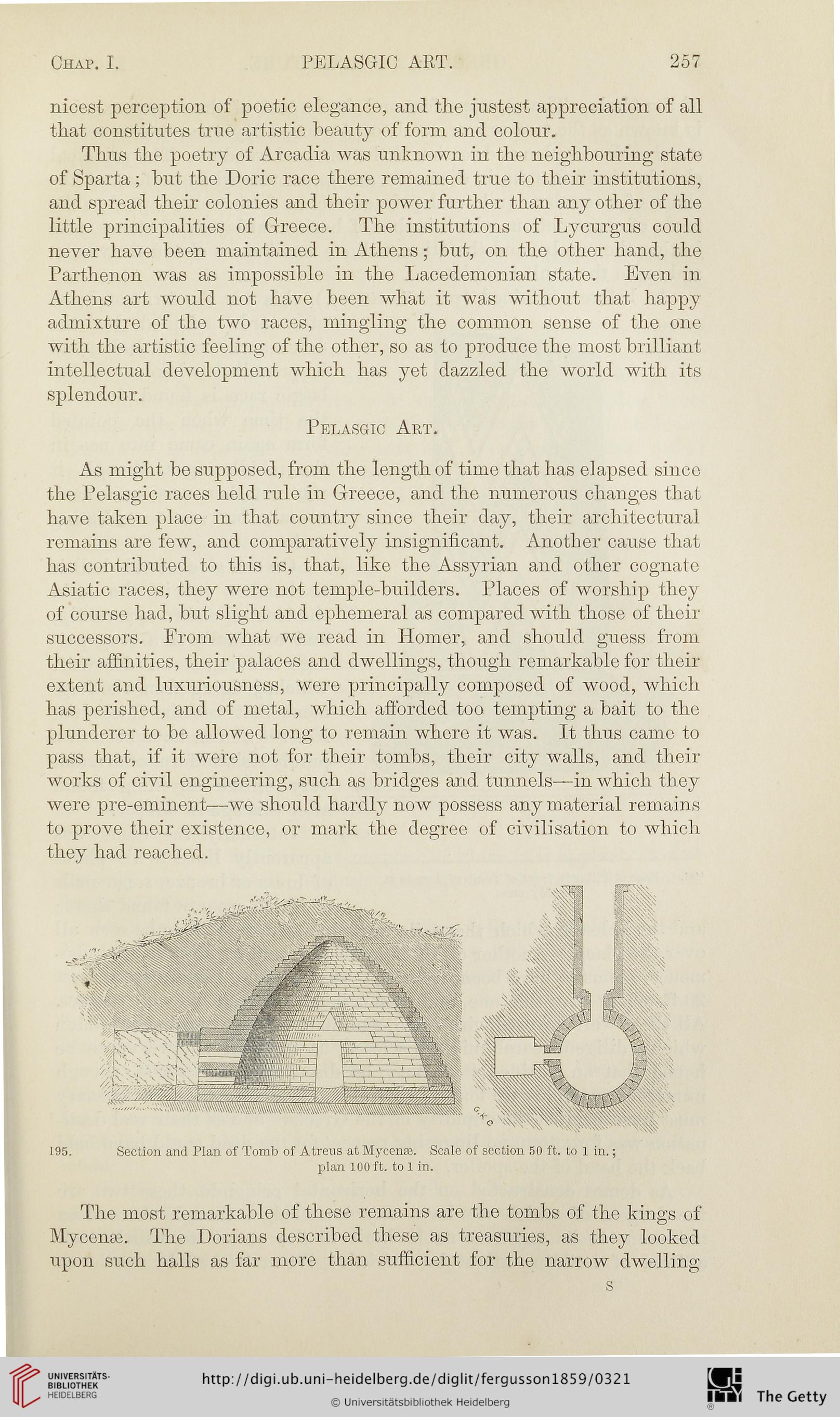Chap. I.
PBLASGIC ART.
257
nicest perception of poetic elegance, and the jnstest appreciation of all
that constitutes true artistic heauty of forrn and colour.
Thus the poetry of Arcadia was unknown in the neighhouring state
of Sparta; hut the Doric race there reruained true to tlieir institutions,
and spread their colonies and their power further than any other of the
little principalities of Greece. The institutions of Lycurgus could
never have heen maintained in Athens; hut, on the other hand, the
Parthenon was as impossihle in the Lacedemonian state. Even in
Athens art would not have heen what it was without that happy
admisture of the two races, mingling the common sense of the one
with the artistic feeling of the other, so as to produce the most hrilliant
intellectual development which has yet dazzled the world witli its
splendour.
Pelasoic Art.
As might he supposed, from the length of time that has elapsed since
the Pelasgic races held rule in Greece, and the numerous changes that
have taken place in that country since their day, their architectural
remains are few, and comparatively insignificant. Another cause that
has contrihuted to this is, that, like the Assyrian and other cognate
Asiatic races, they were not temple-huilders. Places of worship they
of course had, hut slight and ephemeral as compared witli those of their
successors. Erom what we read in Plomer, and should guess from
their affinities, their palaces and dwellings, though remarkahle for their
extent and luxuriousness, were principally composecl of wood, which
has perished, and of metal, which afi'orded too tempting a hait to the
plunderer to he allowed long to remain where it was. It thus came to
pass that, if it were not for their tomhs, their city walls, and their
works of civil engineering, such as hridges and tunnels—in whicli they
were pre-eminent—we should hardly now possess any material remains
to prove their existence, or mark the degree of civilisation to which
they had reachecl.
195. Section and Plan of Tomb of Atreus at Mycenae. Scale of section 50 ft. to 1 in.;
plan 100 ft. to 1 in.
The most remarkahle of these remains are the tomhs of the kings of
Mycense. The Dorians described these as treasuries, as they looked
upon such halls as far more tlian sufficient for the narrow dwelling
s
PBLASGIC ART.
257
nicest perception of poetic elegance, and the jnstest appreciation of all
that constitutes true artistic heauty of forrn and colour.
Thus the poetry of Arcadia was unknown in the neighhouring state
of Sparta; hut the Doric race there reruained true to tlieir institutions,
and spread their colonies and their power further than any other of the
little principalities of Greece. The institutions of Lycurgus could
never have heen maintained in Athens; hut, on the other hand, the
Parthenon was as impossihle in the Lacedemonian state. Even in
Athens art would not have heen what it was without that happy
admisture of the two races, mingling the common sense of the one
with the artistic feeling of the other, so as to produce the most hrilliant
intellectual development which has yet dazzled the world witli its
splendour.
Pelasoic Art.
As might he supposed, from the length of time that has elapsed since
the Pelasgic races held rule in Greece, and the numerous changes that
have taken place in that country since their day, their architectural
remains are few, and comparatively insignificant. Another cause that
has contrihuted to this is, that, like the Assyrian and other cognate
Asiatic races, they were not temple-huilders. Places of worship they
of course had, hut slight and ephemeral as compared witli those of their
successors. Erom what we read in Plomer, and should guess from
their affinities, their palaces and dwellings, though remarkahle for their
extent and luxuriousness, were principally composecl of wood, which
has perished, and of metal, which afi'orded too tempting a hait to the
plunderer to he allowed long to remain where it was. It thus came to
pass that, if it were not for their tomhs, their city walls, and their
works of civil engineering, such as hridges and tunnels—in whicli they
were pre-eminent—we should hardly now possess any material remains
to prove their existence, or mark the degree of civilisation to which
they had reachecl.
195. Section and Plan of Tomb of Atreus at Mycenae. Scale of section 50 ft. to 1 in.;
plan 100 ft. to 1 in.
The most remarkahle of these remains are the tomhs of the kings of
Mycense. The Dorians described these as treasuries, as they looked
upon such halls as far more tlian sufficient for the narrow dwelling
s




